We apologize for possible errors in the machine translation of the site
2.2. Extent of land cover classes in Armenia
GIS modeling and analysis – Eduard Kazakov (NextGIS OÜ, Estonia)
Analysis and presentation of results – Elena Bukvareva (BCC-Armenia)
Search for government data – Armen Grigoryan (BCC Armenia)
2.2.A. Extent of land cover classes reported by Government of Armenia
The Decision of the Government of the Republic of Armenia in April 11, 2019 n 431-n “On approval of the procedure for classification of the land cover of the Republic of Armenia” defined the following land cover classes for national accounting:
– Cultivated lands
– Grasslands
– Tree-covered areas
– Shrub-covered areas
– Water covered areas
– Vegetation-free areas
Table 1. Land cover of the Republic of Armenia 2974258.8 ha area, by classes, 2020-2024
| Land cover classes | As of July 1, 2020 | As of July 1, 2021 | As of July 1, 2022 | As of July 1, 2023 | As of July 1, 2024 |
| Cultivated lands | 538361.22 | 538580.09 | 538930.12 | 538919.19 | 539620.52 |
| Grasslands | 1366386.896 | 1371066.28 | 1370749.11 | 1370618.62 | 1363686.44 |
| Tree-covered areas | 400522.06 | 400375.84 | 400279.49 | 382109.06 | 382361.15 |
| Shrub-covered areas | 34200.612 | 34193.77 | 34135.56 | 34124.48 | 34374.33 |
| Water covered areas | 151491.8 | 153889.698 | 153890.39 | 172088.29 | 172117.81 |
| Vegetation-free areas | 483295.83 | 476152.342 | 476274.17 | 476398.959 | 482098.73 |

Figure 1. The share of land cover classes in Armenia by Government-reported data
The more detailed disaggregation of land cover classes by land fund categories provided in the Government-reported data, enables the separation of vegetation-free anthropogenic areas, i.e., built-up areas from natural ones and makes it possible to compare Governmental data and land cover datasets (see here). The result with reclassified vegetation-free areas for Armenia and across marzes is shown un Fig.2.
How to classify grasslands and cultivated lands located within settlement boundaries is a question that needs to be addressed in order to harmonize satellite-based land cover classifications with official land cover statistics. At this stage of the analysis, we kept these lands within grasslands and cultivated lands, respectively.
Figure 2. The share of land cover classes in Armenia and across marzes by Government-reported data
Sources:
(2021) http://www.irtek.am/DOCUMENTS/PDF/148034_havelvac.pdf
(2021) https://faolex.fao.org/docs/pdf/arm209550.pdf
(2022) http://www.irtek.am/views/act.aspx?aid=156501
(2022) https://www.arlis.am/DocumentView.aspx?DocID=171671
(2023) https://www.e-draft.am/projects/6427/about
(2024) https://www.e-draft.am/projects/7902/about
2.2.B. Extent of land cover classes by ESRI data
Since the ESRI land cover dataset was selected for use in the project, the subsequent extent assessment was conducted by ESRI data вased on the area of 1 pixel equal to 100 m2. The extent of different land cover classes according to the other datasets can be found here. 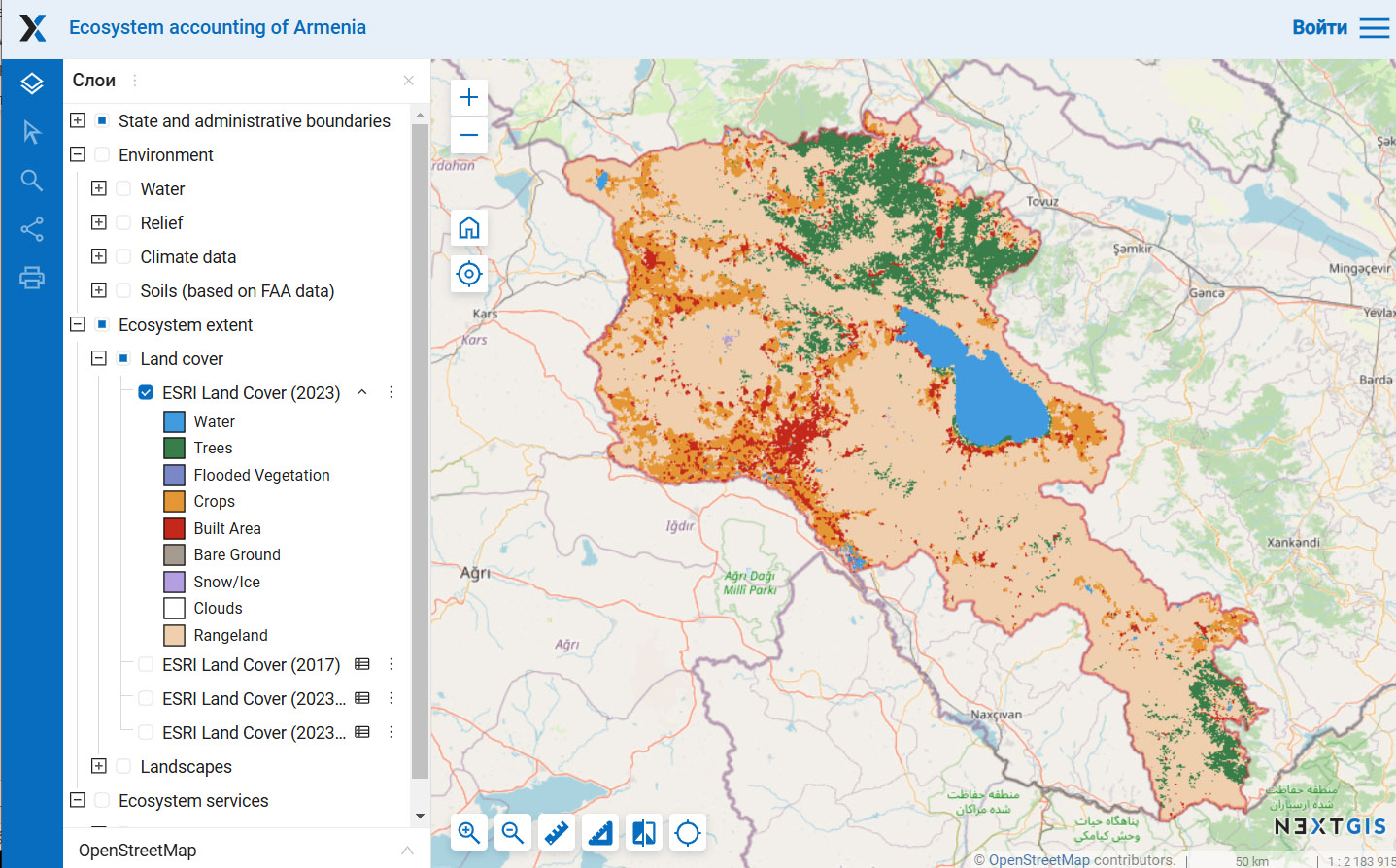
Figure 3. ESRI dataset for the territory of Armenia. For detailed maps see sections “Ecosystem extent – Landcover” here
National and marz levels
The majority of Armenia’s territory is covered by grasslands (68% аccording to ESRI data), forests occupy 11% (compared to 13% according to Government data), croplands and built-up areas account for 12% and 5%, respectively. The most human-transformed marz is Armavir, where croplands and built-up areas together make up over 60% of the territory. The least transformed marzes are Vayots Dzor, Tavush, and Syunik. Forests cover the largest area in Tavush (around 50%), and are also widespread in Lori, where they exceed 20% of the territory.
Area of land cover classes in 2017, km2
| Rangeland | Trees | Bare Ground | Snow/Ice | Flooded vegetation | Water | Crops | Built Area | Total | |
| ARAGATSOTN | 2,161.08 | 52.54 | 12.60 | 0.02 | 0.00 | 3.43 | 380.13 | 126.33 | 2,736.12 |
| ARARAT | 1,522.66 | 30.47 | 16.35 | 0.01 | 11.71 | 29.16 | 359.92 | 144.64 | 2,114.91 |
| ARMAVIR | 455.53 | 2.84 | 5.45 | 0.00 | 1.81 | 6.67 | 645.14 | 146.25 | 1,263.70 |
| GEGHARKUNIK | 3,320.37 | 134.93 | 19.08 | 0.04 | 1.40 | 1,274.09 | 315.10 | 182.98 | 5,248.00 |
| KOTAYK | 1,506.57 | 171.74 | 7.47 | 0.74 | 0.01 | 2.49 | 270.63 | 155.14 | 2,114.80 |
| LORI | 2,558.39 | 869.51 | 4.55 | 0.02 | 0.44 | 2.64 | 189.21 | 138.24 | 3,763.00 |
| SHIRAK | 1,998.79 | 13.08 | 4.31 | 0.00 | 0.07 | 27.21 | 537.55 | 137.61 | 2,718.63 |
| SYUNIK | 3,571.06 | 634.26 | 33.14 | 0.13 | 0.04 | 17.98 | 170.64 | 66.09 | 4,493.35 |
| TAVUSH | 1,234.28 | 1,304.10 | 1.34 | 0.00 | 0.00 | 4.00 | 91.52 | 91.00 | 2,726.24 |
| VAYOTZ DZOR | 2,157.65 | 47.10 | 14.01 | 0.02 | 0.01 | 2.76 | 35.26 | 39.74 | 2,296.54 |
| ARMENIA | 20,549.27 | 3,261.03 | 119.68 | 0.97 | 15.47 | 1,371.25 | 3,018.23 | 1,372.59 | 29,708.49 |
Area of land cover classes in 2023, km2
| Rangeland | Trees | Bare Ground | Snow/Ice | Flooded vegetation | Water | Crops | Built Area | Total | |
| ARAGATSOTN | 2,096.86 | 48.25 | 3.48 | 6.38 | 0.00 | 3.50 | 438.49 | 139.17 | 2,736.12 |
| ARARAT | 1,560.01 | 26.20 | 6.94 | 0.04 | 6.74 | 32.42 | 305.46 | 177.10 | 2,114.91 |
| ARMAVIR | 461.83 | 0.55 | 2.05 | 0.00 | 0.15 | 7.10 | 609.26 | 182.76 | 1,263.70 |
| GEGHARKUNIK | 3,239.85 | 129.56 | 4.28 | 0.94 | 0.65 | 1,274.08 | 404.99 | 193.66 | 5,248.00 |
| KOTAYK | 1,508.64 | 153.10 | 1.08 | 1.60 | 0.00 | 2.57 | 265.38 | 182.43 | 2,114.80 |
| LORI | 2,424.92 | 883.74 | 2.83 | 0.31 | 0.79 | 3.81 | 298.87 | 147.73 | 3,763.00 |
| SHIRAK | 1,784.67 | 13.43 | 0.91 | 2.47 | 0.00 | 31.48 | 742.89 | 142.79 | 2,718.63 |
| SYUNIK | 3,650.25 | 507.74 | 12.65 | 0.09 | 0.02 | 15.86 | 233.22 | 73.53 | 4,493.35 |
| TAVUSH | 1,227.75 | 1,316.33 | 0.05 | 0.04 | 0.02 | 4.35 | 82.03 | 95.67 | 2,726.24 |
| VAYOTZ DZOR | 2,174.55 | 38.13 | 2.51 | 0.35 | 0.00 | 2.35 | 33.28 | 45.37 | 2,296.54 |
| ARMENIA | 20,185.02 | 3,117.51 | 37.33 | 12.21 | 8.39 | 1,378.29 | 3,422.08 | 1,547.66 | 29,708.49 |
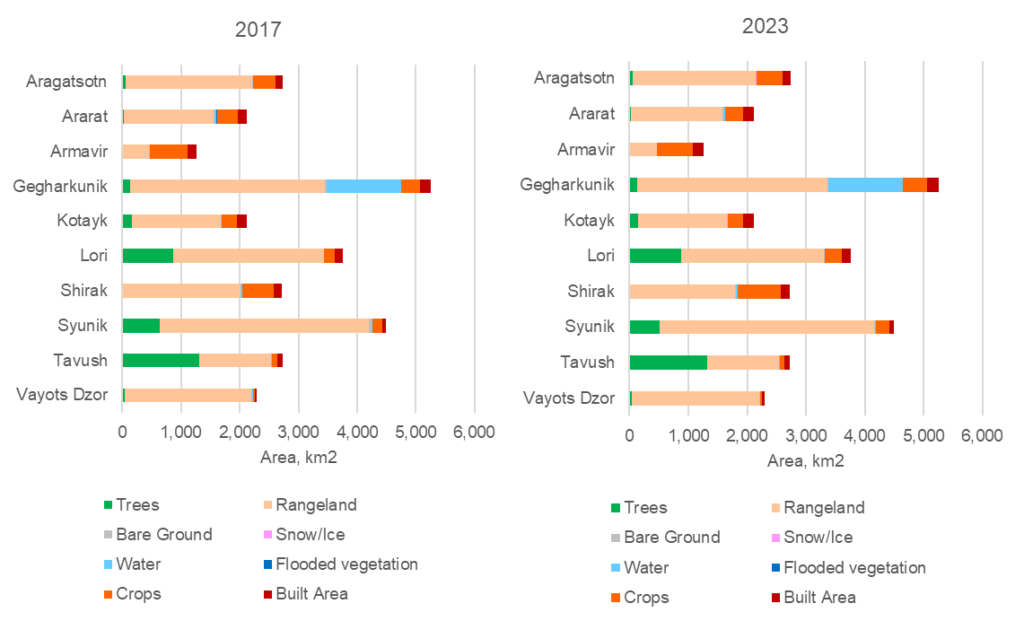
Figure 4. Area of land cover classes across marzes in 2017 and 2023, km2
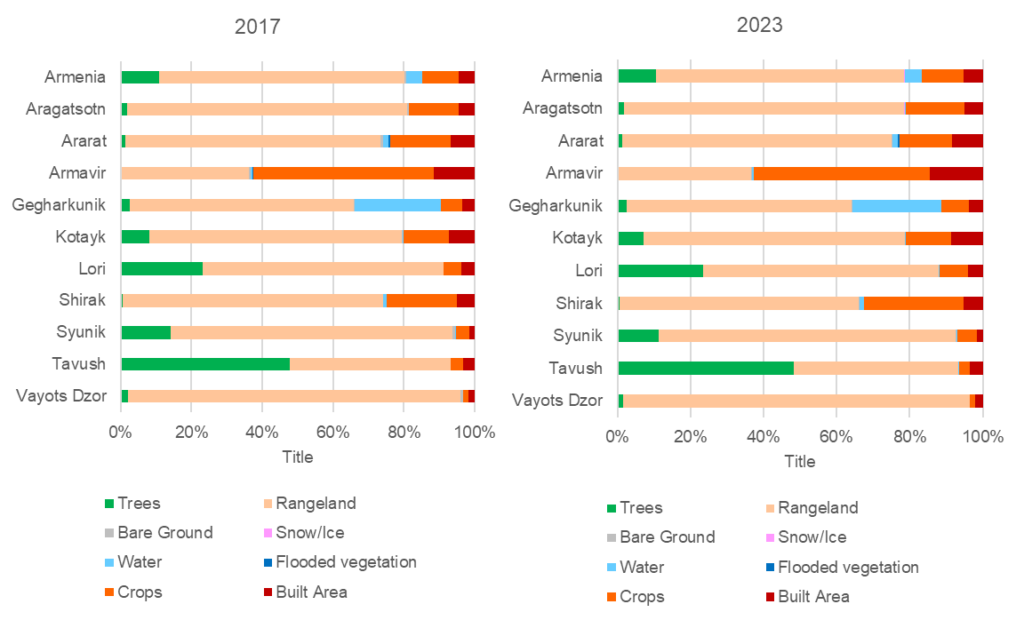
Figure 5. The share of area of land cover classes in Armenia and across marzes in 2017 and 2023, %
Between 2017 and 2023, according to ESRI data, the area of croplands and built-up areas in Armenia increased by 404 km² and 175 km², respectively, while the area of forests and grasslands decreased by 144 km² and 364 km². The most significant changes occurred in Shirak marz, where cropland area increased by 200 km² at the expense of grasslands. Similar but less extensive cropland expansion at the expense of grasslands took place in Lori, Gegharkunik, and Aragatsotn. In contrast, in Armavir and Ararat, cropland area decreased. In Armavir, this was due to an increase in built-up areas, while in Ararat, it resulted from both an expansion of built-up areas and grasslands. In Syunik marz, forest area noticeably declined due to an increase in grasslands and croplands. Relative changes in land cover areas present a somewhat different picture. In 2023, the ESRI land cover dataset shows an 80% loss of tree cover in Armavir marz compared to 2017, although this loss is barely noticeable in absolute terms due to the initially small woody area in that marz. The largest relative increase in cropland area was identified in Lori marz — nearly 60%.
Changes in area of land cover classes from 2017 to 2023, km2
| Rangeland | Trees | Bare Ground | Snow/Ice | Flooded vegetation | Water | Crops | Built Area | |
| ARAGATSOTN | -64.22 | -4.29 | -9.12 | 6.36 | 0.00 | 0.06 | 58.36 | 12.84 |
| ARARAT | 37.35 | -4.28 | -9.42 | 0.04 | -4.96 | 3.27 | -54.46 | 32.46 |
| ARMAVIR | 6.30 | -2.29 | -3.41 | 0.00 | -1.65 | 0.43 | -35.88 | 36.50 |
| GEGHARKUNIK | -80.52 | -5.37 | -14.81 | 0.90 | -0.75 | -0.02 | 89.89 | 10.68 |
| KOTAYK | 2.07 | -18.64 | -6.39 | 0.86 | -0.01 | 0.08 | -5.26 | 27.28 |
| LORI | -133.47 | 14.22 | -1.72 | 0.28 | 0.35 | 1.17 | 109.66 | 9.50 |
| SHIRAK | -214.12 | 0.34 | -3.40 | 2.47 | -0.06 | 4.26 | 205.33 | 5.18 |
| SYUNIK | 79.18 | -126.52 | -20.49 | -0.04 | -0.02 | -2.12 | 62.58 | 7.44 |
| TAVUSH | -6.54 | 12.23 | -1.28 | 0.04 | 0.02 | 0.35 | -9.49 | 4.68 |
| VAYOTZ DZOR | 16.90 | -8.97 | -11.50 | 0.33 | -0.01 | -0.41 | -1.98 | 5.63 |
| ARMENIA | -364.25 | -143.52 | -82.35 | 11.23 | -7.08 | 7.04 | 403.85 | 175.08 |
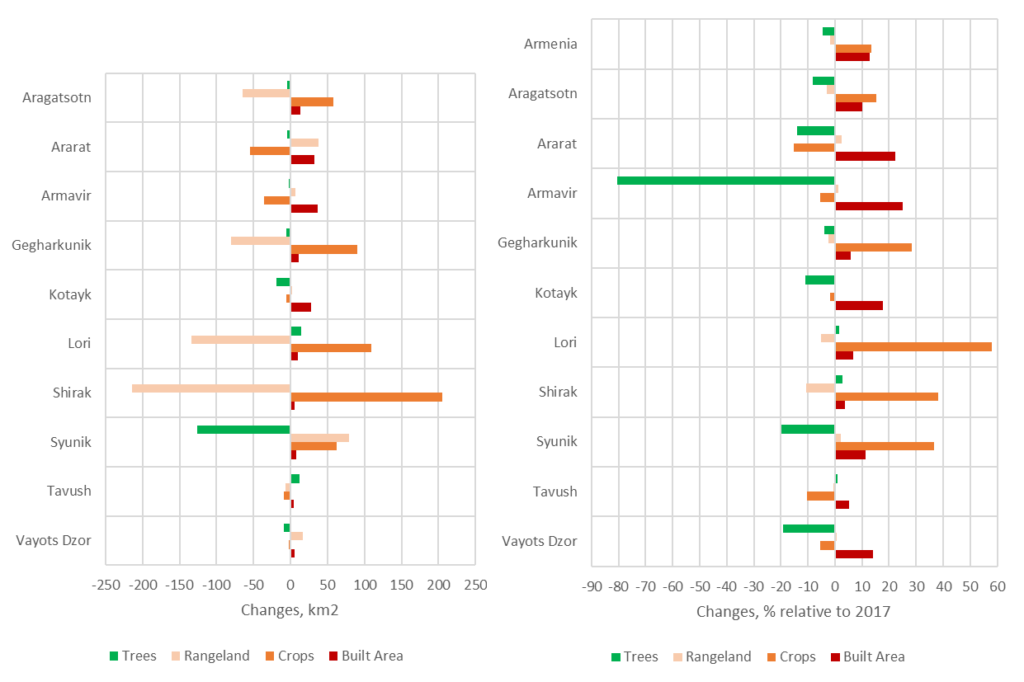
Figure 6. Absolute (km2) and relative (% of 2017 area) changes in area of the main land cover classes in Armenia and across marzes from 2017 to 2023
Watersheds
Land cover class extent accounting was also carried out for the large watersheds, since one of the key purposes of ecosystem accounting is to assess water-regulating ecosystem services, which are modeled at the watershed level. Since in Armenia watershed boundaries largely coincide with marz boundaries (the Hrazdan, Metsamor, and Arpa watersheds each include two marzes), the pattern of land cover class area distribution and its changes from 2017 to 2023 mirrors the pattern identified at the marz level.
The most human-transformed watersheds are Metsamor (marzes Aragatsotn and Armavir) and Akhuryan (marz Shirak), where croplands and built-up areas together make up around 30% of the territory. The least transformed watersheds are Aghstev (marz Tavush) and Vorotan (marz Syunik). Forests cover large areas in Aghstev watershed (marz Tavush) and Debed watershed (marz Lori).
Area of land cover classes, km2
| Rangeland | Trees | Bare Ground | Snow/Ice | Flooded vegetation | Water | Crops | Built Area | ||
| 2017 | Aghstev | 1600.07 | 1401.27 | 1.99 | 0.01 | 0.00 | 3.70 | 69.63 | 98.72 |
| Akhuryan | 1999.78 | 9.30 | 4.42 | 0.00 | 0.07 | 27.25 | 599.85 | 144.59 | |
| Arpa | 3839.27 | 79.92 | 30.63 | 0.15 | 10.84 | 26.36 | 288.32 | 134.83 | |
| Debed | 2719.90 | 843.51 | 4.83 | 0.02 | 0.44 | 3.11 | 212.89 | 141.05 | |
| Hrazdan | 4384.18 | 243.39 | 27.42 | 0.65 | 1.68 | 1281.05 | 765.19 | 545.57 | |
| Metsamor | 2420.53 | 49.32 | 17.31 | 0.02 | 2.41 | 11.80 | 911.62 | 241.75 | |
| Vorotan | 3573.45 | 634.26 | 32.93 | 0.13 | 0.04 | 17.98 | 170.65 | 66.09 | |
| 2023 | Aghstev | 1590.30 | 1397.07 | 0.09 | 0.08 | 0.02 | 4.04 | 80.02 | 103.76 |
| Akhuryan | 1801.94 | 9.54 | 0.90 | 2.36 | 0.00 | 31.54 | 789.01 | 149.95 | |
| Arpa | 3890.99 | 66.30 | 9.26 | 0.73 | 6.22 | 29.55 | 249.59 | 157.67 | |
| Debed | 2575.47 | 865.33 | 2.84 | 0.27 | 0.79 | 4.29 | 325.58 | 151.17 | |
| Hrazdan | 4305.51 | 228.70 | 6.24 | 2.17 | 0.67 | 1280.73 | 794.73 | 630.37 | |
| Metsamor | 2356.44 | 42.74 | 5.25 | 6.48 | 0.66 | 12.27 | 949.72 | 281.20 | |
| Vorotan | 3652.35 | 507.74 | 12.65 | 0.11 | 0.02 | 15.86 | 233.26 | 73.54 |
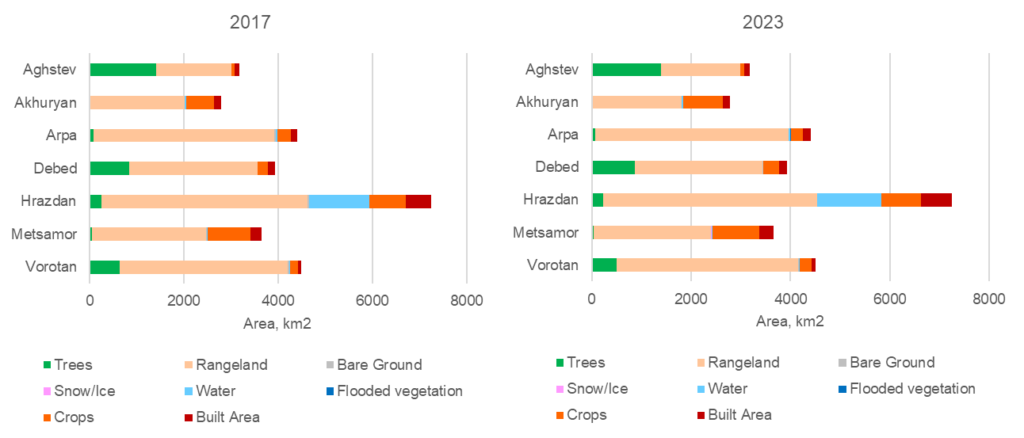
Figure 7. Area of land cover classes across watersheds in 2017 and 2023, km2
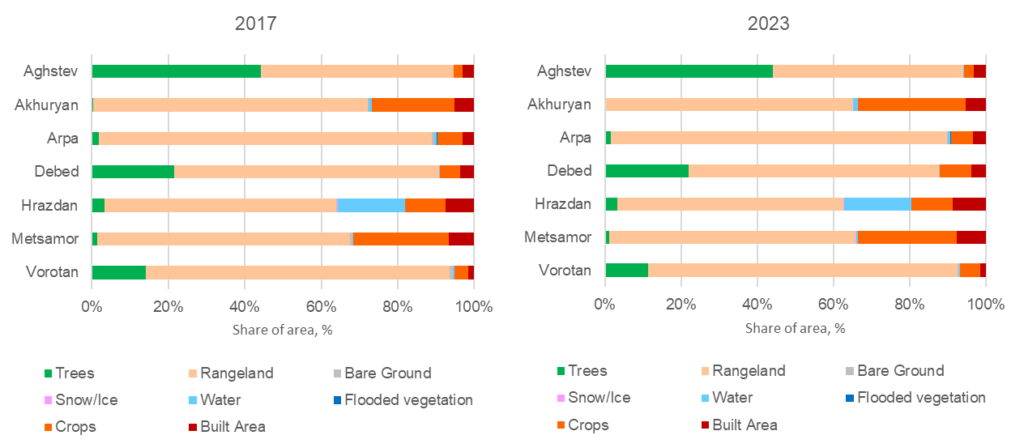
Figure 8. The share of area of land cover classes across watersheds in 2017 and 2023, %
The most significant changes in land cover area occurred in Akhurian watershed (Shirak marz), where cropland area increased by 200 km² at the expense of grasslands. Similar but less extensive cropland expansion at the expense of grasslands took place in Debed watershed (Lori marz). In the Razdan and Metsamor watersheds, grassland areas decreased due to the expansion of croplands and built-up areas. Changes in the Arpa watershed are driven by changes in Ararat marz, where cropland area decreased due to the expansion of built-up areas and grasslands. In Vorotan watershed (Syunik marz), forest area noticeably declined due to an increase in grasslands and croplands.
Relative changes show the largest relative increase in cropland area in Debed watershed (Lori marz) and significant increase in cropland area in Vorotan watershed (Syunik marz) and Akhuryan watershed (Shirak marz). In the Vorotan, Arpa, and Metsamor watersheds, forest area decreased by 10–20%.
Changes in area of land cover classes across watersheds from 2017 to 2023, km2
| Rangeland | Trees | Bare Ground | Snow/Ice | Flooded vegetation | Water | Crops | Built Area | |
| Aghstev | -9.77 | -4.20 | -1.90 | 0.08 | 0.02 | 0.34 | 10.39 | 5.04 |
| Akhuryan | -197.84 | 0.25 | -3.52 | 2.36 | -0.06 | 4.29 | 189.17 | 5.35 |
| Arpa | 51.72 | -13.62 | -21.36 | 0.58 | -4.62 | 3.19 | -38.73 | 22.85 |
| Debed | -144.43 | 21.82 | -1.99 | 0.25 | 0.35 | 1.18 | 112.69 | 10.12 |
| Hrazdan | -78.67 | -14.69 | -21.18 | 1.52 | -1.01 | -0.32 | 29.54 | 84.81 |
| Metsamor | -64.09 | -6.59 | -12.06 | 6.46 | -1.75 | 0.47 | 38.10 | 39.46 |
| Vorotan | 78.89 | -126.52 | -20.28 | -0.02 | -0.02 | -2.12 | 62.62 | 7.45 |
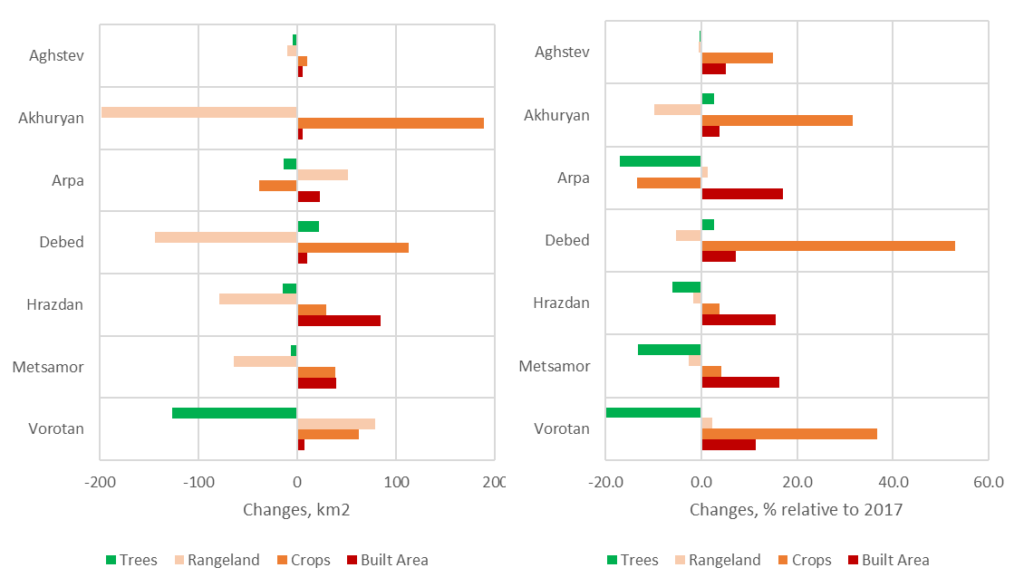
Figure 9. Absolute (km2) and relative (% of 2017 area) changes in area of the main land cover classes across watersheds from 2017 to 2023